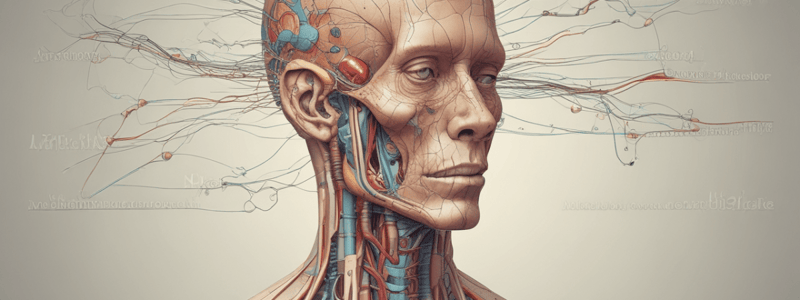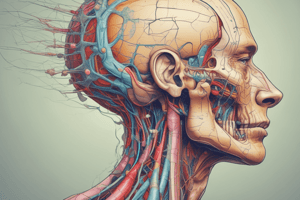Podcast
Questions and Answers
Which cranial nerve is responsible for transmitting visual information from the eye to the brain?
Which cranial nerve is responsible for transmitting visual information from the eye to the brain?
- Optic Nerve (II) (correct)
- Olfactory Nerve (I)
- Trochlear Nerve (IV)
- Oculomotor Nerve (III)
Which nerve is responsible for regulating pupil size and eye movement?
Which nerve is responsible for regulating pupil size and eye movement?
- Trigeminal Nerve (V)
- Trochlear Nerve (IV)
- Abducens Nerve (VI)
- Oculomotor Nerve (III) (correct)
Which nerve controls the superior oblique muscle, which rotates the eyeball?
Which nerve controls the superior oblique muscle, which rotates the eyeball?
- Abducens Nerve (VI)
- Trigeminal Nerve (V)
- Trochlear Nerve (IV) (correct)
- Oculomotor Nerve (III)
Which cranial nerve is responsible for controlling facial expressions and taste?
Which cranial nerve is responsible for controlling facial expressions and taste?
Which nerve is responsible for transmitting sound information from the inner ear to the brain?
Which nerve is responsible for transmitting sound information from the inner ear to the brain?
Which cranial nerve controls tongue movements, including sticking out and side-to-side movements?
Which cranial nerve controls tongue movements, including sticking out and side-to-side movements?
Which nerve is responsible for controlling heart rate and blood pressure?
Which nerve is responsible for controlling heart rate and blood pressure?
Which nerve is responsible for controlling neck and shoulder muscles?
Which nerve is responsible for controlling neck and shoulder muscles?
What cranial nerves are involved in the pupillary light reflex?
What cranial nerves are involved in the pupillary light reflex?
What type of reflex is the pupillary light reflex?
What type of reflex is the pupillary light reflex?
What cranial nerves are involved in the corneal reflex?
What cranial nerves are involved in the corneal reflex?
Which cranial nerves are involved in the gag reflex?
Which cranial nerves are involved in the gag reflex?
What does Cranial Nerve II (Optic Nerve) primarily sense?
What does Cranial Nerve II (Optic Nerve) primarily sense?
What is the primary purpose of cranial nerve III?
What is the primary purpose of cranial nerve III?
What cranial nerves are involved in eye movement?
What cranial nerves are involved in eye movement?
What is the motor function of Cranial Nerve (CN) V?
What is the motor function of Cranial Nerve (CN) V?
What is the sensory function of Cranial Nerve V (Trigeminal Nerve)?
What is the sensory function of Cranial Nerve V (Trigeminal Nerve)?
What is the sensory component of CN VII?
What is the sensory component of CN VII?
What is the motor function of Cranial Nerve VII?
What is the motor function of Cranial Nerve VII?
What type of nerve is CN VIII?
What type of nerve is CN VIII?
What is the motor function of CN IX (Glossopharyngeal Nerve)?
What is the motor function of CN IX (Glossopharyngeal Nerve)?
What is the sensory function of Cranial Nerve IX (CN IX)?
What is the sensory function of Cranial Nerve IX (CN IX)?
What is the motor function of Cranial Nerve XI (Accessory Nerve)?
What is the motor function of Cranial Nerve XI (Accessory Nerve)?
What is the motor function of the Cranial Nerve XII (Hypoglossal Nerve)?
What is the motor function of the Cranial Nerve XII (Hypoglossal Nerve)?
What is the motor function of Cranial Nerve X (Vagus Nerve)?
What is the motor function of Cranial Nerve X (Vagus Nerve)?
What is the primary function of the vagus nerve?
What is the primary function of the vagus nerve?
Which cranial nerve senses taste from the anterior 2/3 of the tongue?
Which cranial nerve senses taste from the anterior 2/3 of the tongue?
Which cranial nerve is involved in facial sensation?
Which cranial nerve is involved in facial sensation?
What is the only cranial nerve that is part of the central nervous system (CNS)?
What is the only cranial nerve that is part of the central nervous system (CNS)?
Injury to which cranial nerve causes Bell's palsy?
Injury to which cranial nerve causes Bell's palsy?
LR6 = lateral rectus innervated by CN 6 (abducens)
LR6 = lateral rectus innervated by CN 6 (abducens)
SO4 = superior oblique innervated by CN4 (trochlear)
SO4 = superior oblique innervated by CN4 (trochlear)
O3 = 3 other muscles (superior, inferior, medial recti, and inferior oblique) innervated by CN3 (oculomotor)
O3 = 3 other muscles (superior, inferior, medial recti, and inferior oblique) innervated by CN3 (oculomotor)
What is the motor function of cranial nerve VI (abducens nerve)?
What is the motor function of cranial nerve VI (abducens nerve)?
What is the motor function of cranial nerve IV (Trochlear nerve)?
What is the motor function of cranial nerve IV (Trochlear nerve)?
Flashcards are hidden until you start studying
Study Notes
Overview
- 12 pairs of cranial nerves emerge from the brain, responsible for controlling various sensory and motor functions
- Each nerve has a specific function and is identified by a Roman numeral (I-XII) and a descriptive name
Cranial Nerves and Their Functions
- Olfactory Nerve (I)
- Responsible for sense of smell
- Optic Nerve (II)
- Transmits visual information from the eye to the brain
- Oculomotor Nerve (III)
- Controls eye movements, including rotation, elevation, and focusing
- Regulates pupil size and eyelid movement
- Trochlear Nerve (IV)
- Controls superior oblique muscle, which rotates the eyeball
- Trigeminal Nerve (V)
- Divided into three branches:
- Ophthalmic branch: sensory information from the eye and surrounding area
- Maxillary branch: sensory information from the upper jaw and face
- Mandibular branch: motor control of chewing muscles and sensory information from the lower jaw and face
- Divided into three branches:
- Abducens Nerve (VI)
- Controls lateral rectus muscle, which rotates the eyeball outward
- Facial Nerve (VII)
- Controls facial expressions, taste, and hearing
- Regulates salivation and lacrimation
- Auditory Nerve (VIII)
- Transmits sound information from the inner ear to the brain
- Glossopharyngeal Nerve (IX)
- Controls swallowing and salivation
- Regulates taste and sensation in the posterior one-third of the tongue
- Vagus Nerve (X)
- Controls various bodily functions, including:
- Heart rate and blood pressure
- Digestion and gut motility
- Swallowing and speech
- Sensation in the ear and throat
- Controls various bodily functions, including:
- Accessory Nerve (XI)
- Controls neck and shoulder muscles
- Assists in swallowing and speech
- Hypoglossal Nerve (XII)
- Controls tongue movements, including sticking out and side-to-side movements
Cranial Nerves
- 12 pairs of cranial nerves emerge from the brain, responsible for controlling various sensory and motor functions
- Each nerve has a specific function and is identified by a Roman numeral (I-XII) and a descriptive name
Cranial Nerve Functions
- Olfactory Nerve (I) senses smell
- Optic Nerve (II) transmits visual information from the eye to the brain
- Oculomotor Nerve (III) controls eye movements, pupil size, and eyelid movement
- Trochlear Nerve (IV) controls superior oblique muscle, which rotates the eyeball
- Trigeminal Nerve (V) has three branches:
- Ophthalmic branch: senses the eye and surrounding area
- Maxillary branch: senses the upper jaw and face
- Mandibular branch: controls chewing muscles and senses the lower jaw and face
- Abducens Nerve (VI) controls lateral rectus muscle, which rotates the eyeball outward
- Facial Nerve (VII) controls facial expressions, taste, and hearing, and regulates salivation and lacrimation
- Auditory Nerve (VIII) transmits sound information from the inner ear to the brain
- Glossopharyngeal Nerve (IX) controls swallowing and salivation, and regulates taste and sensation in the posterior one-third of the tongue
- Vagus Nerve (X) controls:
- Heart rate and blood pressure
- Digestion and gut motility
- Swallowing and speech
- Sensation in the ear and throat
- Accessory Nerve (XI) controls neck and shoulder muscles, and assists in swallowing and speech
- Hypoglossal Nerve (XII) controls tongue movements, including sticking out and side-to-side movements
Studying That Suits You
Use AI to generate personalized quizzes and flashcards to suit your learning preferences.




